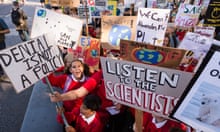The Chevron refinery that looms over Richmond, California, its muted orange tanks nestled into the scrubby low-slung hills above San Francisco Bay, is older than the city itself.
The refinery processes nearly 250,000 barrels of crude oil each day. When it “flares”, as it did more often in 2018 than in any other year over the past decade, dark smoke spirals up and across town in the bay breeze.
When it explodes, like it did in 1989, 1999 and 2012, the thick cloud is visible across the bay and beyond, a blot against the sky that ascends before falling and settling on everything within a multi-mile vicinity that is not covered, closed or sealed up.
A fire on 6 August 2012 sent more than 15,000 people to seek treatment for respiratory distress at local hospitals.
Richmond has long been known for the three Cs: crime, corruption and Chevron. You could also add coal to that list, which the Levin-Richmond terminal began exporting out of the city in 2013, along with coke, the petroleum-refining byproduct.
Despite its proximity to San Francisco and Silicon Valley’s wealth, Richmond’s median household income is below the California state average, with more than 15% of residents living in poverty. More than 80% of residents are people of colour. And Richmond children have roughly twice the rate of asthma as their neighbours countywide.
“It’s a textbook example of an environmental justice community,” said Matt Holmes, the executive director of the nonprofit Groundwork Richmond. “I think the whole country owes Richmond a debt.”
And the city is here to collect. Richmond may be a company city, but it is in open and sustained conflict with the industries that sustain it. Environmental justice activists here are fighting a multi-front war against the fossil fuels that gave the city life, but which, they argue, are also slowly killing it.
Q&AWhat is the polluters project?
Show
The Guardian has collaborated with leading scientists and NGOs to expose, with exclusive data, investigations and analysis, the fossil fuel companies that are perpetuating the climate crisis – some of which have accelerated their extraction of coal, oil and gas even as the devastating impact on the planet and humanity was becoming clear.
The investigation has involved more than 20 Guardian journalists working across the world for the past six months.
The project focuses on what the companies have extracted from the ground, and the subsequent emissions they are responsible for, since 1965. The analysis, undertaken by Richard Heede at the Climate Accountability Institute, calculates how much carbon is emitted throughout the supply chain, from extraction to use by consumers. Heede said: "The fact that consumers combust the fuels to carbon dioxide, water, heat and pollutants does not absolve the fossil fuel companies from responsibility for knowingly perpetuating the carbon era and accelerating the climate crisis toward the existential threat it has now become."
One aim of the project is to move the focus of debate from individual responsibilities to power structures – so our reporters also examined the financial and lobbying structures that let fossil fuel firms keep growing, and discovered which elected politicians were voting for change.
Another aim of the project is to press governments and corporations to close the gap between ambitious long-term promises and lacklustre short-term action. The UN says the coming decade is crucial if the world is to avoid the most catastrophic consequences of global heating. Reining in our dependence on fossil fuels and dramatically accelerating the transition to renewable energy has never been more urgent.
California’s Democratic politics and green global reputation belie the state’s large role in fossil fuel production. The five refineries that dot the eastern span of the bay coast have a combined daily capacity of more than 825,000 barrels, and four of the five export the oil-refining byproduct pet coke.
Chevron’s roots run deep in California – its headquarters is 34 miles inland from Richmond. The company contributes at least 10% of the city’s budget through property taxes and fees, which it has frequently contested in court, seeking refunds and reductions.

It also employs more people than any other single company – 3,456 in 2016 – gives back tens of millions in local community benefits and operates its own local online newspaper, the Richmond Standard, to get out the good word about the fossil fuel giant.
The population in closest proximity to the refinery has disproportionately high rates of cardiovascular disease and cancer. Data from the California Environmental Protection Agency places every community bordering the Chevron facility in the 99th centile for asthma.
And since the refinery’s modernisation plan has come online, with the addition of a new hydrogen plant, its incidents have spiked.
It was this Richmond that in 2003 inspired activists to form the Richmond Progressive Alliance. The RPA ran a multi-partisan list of candidates for city government in 2004, who vowed to take no corporate money, instead keeping their hands clean and ready to take on Chevron should they win office.
“The community in many ways were like: ‘Chevron’s been here for ever, you know, for 100 years, and we can’t beat City Hall when they are all aligned with Chevron. Chevron’s got control,’” said the RPA co-founder Gayle McLaughlin. “And we said, no, that’s not true. We can do this – we have to do this.”
McLaughlin won a seat on the city council and went on to serve two terms as mayor. The RPA turned the tide in Richmond politics swiftly and decisively. Along with local environmental groups including Communities for a Better Environment, the Asian Pacific Environmental Network and West County Toxics Coalition, they organised against a refinery expansion. And after the 2012 fire, under Mayor McLaughlin, Richmond sued Chevron for the first time in the city’s history.
In 2014, Chevron spent more than $3m in campaign donations to city council candidates opposing the RPA. “And they bought up every billboard in town,” McLaughlin said. The RPA won a supermajority on the city council.
“All of the things I’m working on come from my constituents – it’s not me. It needs to come from the bottom,” said Eduardo Martinez, an RPA candidate and former Richmond elementary school teacher who was elected to the city council in 2014.
“Elected officials too often get elected and then they just stay in touch marginally,” said McLaughlin, who left Richmond city government in 2017. “But we kept organising.”
A coat of grime
While Richmond progressives were making strides to rein in the city’s most powerful polluter, a new operation began at the port, behind the private walls of the Levin-Richmond terminal.
The Levin-Richmond Terminal Corporation was already exporting pet coke, which contains lead, arsenic and mercury. In 2013, it began exporting coal, too, from Utah and Colorado mines – according to activists, nearly 1m metric tonnes were exported through Richmond in 2018.
Because coal is prone to combust, it is transported in uncovered train cars, leaving the dust to catch the wind and scatter. Local residents and activists only realised what was happening months, if not years, later, when they noticed the new trains and the coat of thin black grime that came with them.
“Historically we have terrible health impacts in Richmond, but we have a whole bunch of sources of pollution,” said Janet Johnson, an organiser at No Coal in Richmond. “This is an issue that has united communities all across Richmond. Residents are saying that we don’t want this.”
Richmond city council passed a resolution in 2015 requesting that local air-quality managers regulate the handling and transportation of coal and pet coke. But the trains kept running, inspiring a new tactic. Richmond may not wield police powers over its air but the city can make rules over how its land is used.
This month, the council will vote on a proposal by Martinez that would phase out the storage and handling of coal and pet coke and prohibit the expansion of new facilities.
“A land use ordinance is very strong. I mean, cities use this for billboards,” Johnson said. “All the city needs is a rational basis for deciding they don’t want this handling and storage of these toxic materials to continue in the interest of public health and safety.”

The Contra Costa county supervisor, John Gioia, grew up in Richmond and has been an outspoken supporter of the ordinance. He also sits on the California Air Resources board and the Bay Area Air Quality Management District board.
“Right now, there’s the most attention to pollution issues in Richmond that I’ve ever seen,” Gioia said. That attention is based on local health and justice.
A bold move
But the global climate crisis is coming for Richmond, too, and its 32 miles of coastline – more than any other Bay Area city.
In January 2018, Richmond followed the lead of seven other California municipalities in filing a suit against Chevron and a further 28 fossil fuel companies, alleging public nuisance and negligence, and seeking the funds necessary to adapt to a climate-changed future. It was a bold move for little Richmond. But, said Martinez, “Where else could we go?”
The lawsuits contend the fossil fuel industry misled the public about the true impact of their products. While defendants attempted to have Richmond v Chevron moved to federal court, arguing that the regulation of emissions was essentially a federal issue, a judge remanded the case back to the state. Richmond v Chevron is pending in the ninth circuit court of appeals. The suit is ongoing.
Vic Sher, counsel for Richmond, said: “These are the first cases to apply this approach to climate change impacts on communities, but far from the first to apply them to injuries to communities suffering from a wide range of bad corporate behaviour.”
He said if a company engages in a “campaign of disinformation about products that it knows are going to harm people and the planet, they are responsible for the injuries they cause”.
And for Richmond and other frontline communities like it, those injuries are disproportionately damaging.
“They’re even more dire in under-resourced communities of colour,” Sher said. “Poor communities face more severe impacts, coupled with less ability to pay the high costs of adaptation and survival.”
Green reputation
Some of California’s global green reputation is well-earned: the state has some of the strongest regulations on toxics, refineries and vehicle emissions in the US.
In response to the Guardian’s questions, Chevron said it had “a longstanding commitment to reduce emissions at our [Richmond] facility.
“Richmond refinery operates under the strict rules and regulations established by the California Air Resources board and the Bay Area Air Quality Management District, the agencies responsible for monitoring and regulating sources of air emissions.”
It declined to answer questions about the lawsuit or the health problems in the area, but pointed to its financial support for local groups, particularly in education.
The “cap and trade” programme, designed to reduce greenhouse gas emissions, has also been hailed as landmark environmental policy.
But politicians and activists in Richmond say it has established a market of pollution for the fossil fuel industry that disproportionately hurts them.
“It does nothing to reduce pollution at their sources, including communities like Richmond, where we’ve seen emissions actually go up, because they’re purchasing offsets they can afford,” said Andrés Soto, an RPA co-founder and community organiser at Communities for a Better Environment.
As part of a bill renewing cap and trade in 2017, the state established volunteer steering committees in highly polluted cities to involve communities in local air-quality planning.
In September, Richmond’s designated committee voted to delay regulation in favour of doing more monitoring. Soto said: “Monitoring is not bad, but monitoring with no emissions-reduction strategy doesn’t accomplish anything other than show you that you’re already getting polluted to the point that it’s dangerous. But we knew that.”
Holmes, who sits on the steering committee, added: “Everybody’s throwing their garbage in the sky and nobody’s really taking a fair assessment of it.”

Some of Groundwork’s money also comes from Chevron. For Holmes, it is all a means to an end: to present economic opportunity and good green jobs to best serve the young guardians of Richmond’s greener future.
“We could be more principled and stomp our feet at the gates of the refinery, but we use that money to provide opportunity for these Richmond youth to do something about it,” Holmes said.
Radical solutions
One way or another, the Chevron refinery will not be in Richmond for ever, and just as the city has had to grapple with the impact of so much pollution, it will also have to contend with the result of that transition – just or otherwise.
“It is the frontline communities that are articulating in many ways the most radical solutions, because they are dealing with the most radical impacts,” Soto said. “As the situation gets worse, people are going to want more radical action. And that is, I think, where the hope is.”










